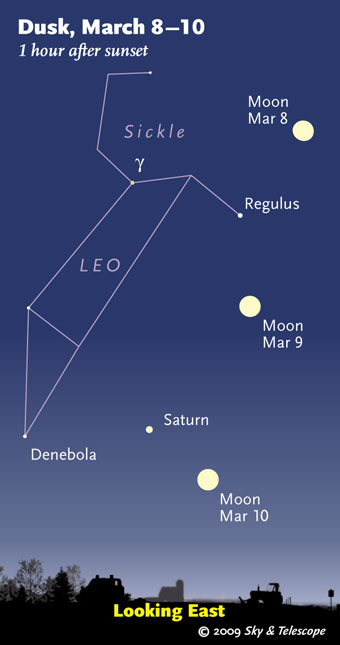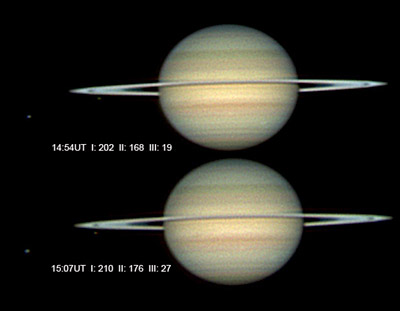Some daily events in the changing sky for March 6 – 14.
Comet Lulin is fading now, from about magnitude 5.5 to 6.5 this week, as it moves away from both Earth and Sun. And there's bright moonlight in the sky until about March 12th. The comet is high in the evening, crossing from Cancer into Gemini. See our article and finder chart.
Friday, March 6
Saturday, March 7

Watch the big bright Moon pass Regulus and Saturn in Leo. (These scenes are drawn for the middle of North America. European observers: move each Moon symbol a quarter of the way toward the one for the previous date. In the Far East, move it halfway.)
Sky & Telescope diagram
Sunday, March 8
Monday, March 9
Tuesday, March 10
Wednesday, March 11
Thursday, March 12
Friday, March 13
Saturday, March 14
Want to become a better amateur astronomer? Learn your way around the constellations. They're the key to locating everything fainter and deeper to hunt with binoculars or a telescope. For an easy-to-use constellation guide covering the whole evening sky, use the big monthly map in each issue of Sky & Telescope, the essential magazine of astronomy. Or download our free Getting Started in Astronomy booklet (which only has bimonthly maps).

The Pocket Sky Atlas plots 30,796 stars to magnitude 7.6 — which may sound like a lot, but that's less than one star in an entire telescopic field of view, on average. By comparison, Sky Atlas 2000.0 plots 81,000 stars to magnitude 8.5, typically one or two stars per telescopic field. Both atlases include many hundreds of deep-sky targets — galaxies, star clusters, and nebulae — among the stars.
Sky & Telescope
Once you get a telescope, to put it to good use you'll need a detailed, large-scale sky atlas (set of charts; the standards are Sky Atlas 2000.0 or the smaller Pocket Sky Atlas) and good deep-sky guidebooks (such as Sky Atlas 2000.0 Companion by Strong and Sinnott, the even more detailed Night Sky Observer's Guide by Kepple and Sanner, or the classic Burnham's Celestial Handbook). Read how to use them effectively.
Can a computerized telescope take their place? As Terence Dickinson and Alan Dyer say in their Backyard Astronomer's Guide, "A full appreciation of the universe cannot come without developing the skills to find things in the sky and understanding how the sky works. This knowledge comes only by spending time under the stars with star maps in hand and a curious mind." Without these, they note, "the sky never becomes a friendly place."
More beginners' tips: "How to Start Right in Astronomy".
This Week's Planet Roundup
Mercury and Mars (magnitudes –0.3, and +1.2, respectively) are very low in the glow of sunrise. Using binoculars, look just above the east-southeast horizon to the lower left of brighter Jupiter about 30 minutes before sunrise. Good luck.
Venus (magnitude –4.7, in Pisces) is the brilliant "Evening Star" in the west during twilight. It's dropping lower every day now! In a telescope, Venus is a rapidly thinning crescent (waning from 13% to just 7% sunlit this week) that enlarges from 50 to 55 arcseconds from cusp to cusp. Telescopically, Venus is best seen in late-afternoon daylight; it's less glary against a bright sky, and it's higher.
Venus is on its way to passing a wide 8° north of the Sun at inferior conjunction on March 27th — a very favorable circumstance for observers at mid-northern latitudes. See the March Sky & Telescope, page 58.
Ceres, the largest asteroid, (magnitude 7.1, above the back of Leo), is still just coming off its closest opposition of our lifetime. Spot it with binoculars using the article and finder chart in the March Sky & Telescope, page 60, or online.
Jupiter (magnitude –2.0) is emerging a little higher into dawn view every day. Look for it low above the east-southeast horizon about 45 minutes before sunrise.

Saturn two days before opposition, imaged by Christopher Go of Cebu, Philippines, on March 6th. "Note that the ring of Saturn is getting brighter," he writes. This is the Seeliger effect, which will peak on opposition night, March 8th.
The images were taken 13 minutes apart. Note the motions of Saturn's moons Dione (left) and Tethys (just below ring) during this time.
Saturn (magnitude +0.5, near the hind foot of Leo) is at opposition this week. It rises around sunset, shines well up in the east by midevening, and is highest in the south around midnight. Don't confuse Saturn with nearly-as-bright Regulus 18° (nearly two fist-widths at arm's length) to its upper right in early evening, and more directly to Saturn's right late at night.
For a few days around opposition, Saturn's rings always brighten with respect to the planet's globe. This is called the Seeliger effect. It happens because the solid, icy particles making up the rings "backscatter" sunlight back toward the Sun and Earth more effectively than the materials making up Saturn's cloudtops.
On a sunny day here on Earth, you sometimes see backscattering from dust on the ground creating a slightly brighter aura around the shadow of your head. Reflective road signs are designed to backscatter light with especially high efficiency.
This week Saturn's rings are tilted 2½° from edge on. The rings will open to 4° by late May, then will close to exactly edge-on next September 4th — when, unfortunately, Saturn will be out of sight practically in conjunction with the Sun.
Uranus is hidden behind the glow of the Sun.
Neptune is deep in the glow of sunrise, hidden in the background of Mercury and Mars.
Pluto (in northwestern Sagittarius) is in the southeast before dawn.
All descriptions that relate to your horizon or zenith — including the words up, down, right, and left — are written for the world's mid-northern latitudes. Descriptions that also depend on longitude (mainly Moon positions) are for North America. Eastern Standard Time (EST) equals Universal Time (known as UT, UTC, or GMT) minus 5 hours. Eastern Daylight Time (EDT) is UT minus 4 hours.
To be sure to get the current Sky at a Glance, bookmark this URL:
http://SkyandTelescope.com/observing/ataglance?1=1
If pictures fail to load, refresh the page. If they still fail to load, change the 1 at the end of the URL to any other character and try again.
 0
0
Comments
You must be logged in to post a comment.